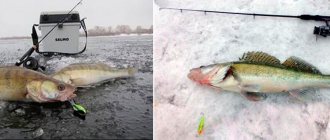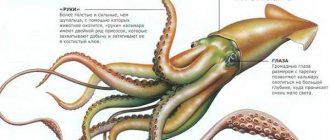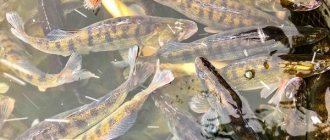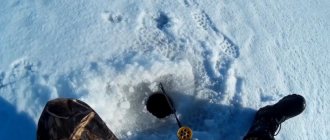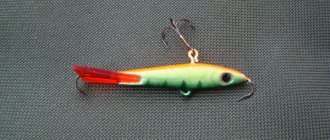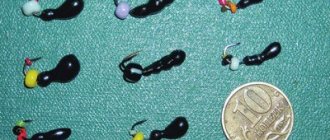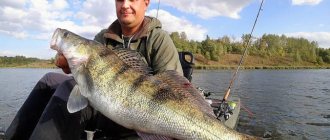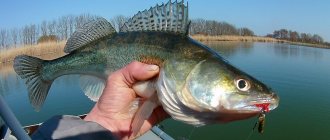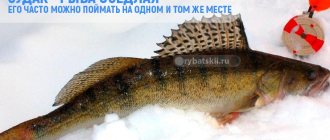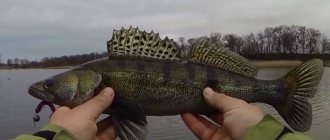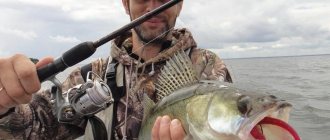Pike perch is highly valued by culinary specialists in all countries where it is found, due to the fact that the meat of this fish is low-fat and practically boneless, and in addition, as many lovers of fish dishes note, it is tasty, tender and very healthy. A huge number of dishes can be prepared from pike perch, so pike perch is the favorite type of fish for most housewives.
In the winter months you can sometimes catch even more pike perch than in the summer. But the way they catch fish in the winter is very different from the way they catch them in the summer.
What to consider when looking for pike perch
In order to find pike perch in the summer, you first need to know the reservoir, the location of depressions and snags on its bottom. But in winter, a school of pike perch will not stand in one place: it must move to find prey. Therefore, the fisherman has to move around a lot in search of this fish, trying to find the most successful fishing spot.
But there is one encouraging circumstance: although the flock moves all the time in winter, it usually follows the same route every year. And if you already know some places for successful fishing, then by repeatedly checking them, you will most likely achieve success. But a school of pike perch does not always behave the same way. Sometimes she may freeze in some place near the bottom and not be interested in either food or bait. It is no longer possible to catch such a pike perch that has fallen into suspended animation.
Features of winter fishing for pike perch
This predator is not caught well all winter: when the period of deep winter sets in, lasting about a month, it is practically impossible to catch it. But the rest of the time, pike perch behaves actively and is constantly looking for food, migrating throughout its habitat. Therefore, fishermen need to constantly move and drill new holes, even if they managed to catch a large specimen in one of them. The flock will not stand still, even if there is enough food there. This behavior of pike perch is written in its genes: in order to survive, you must always move, swimming without stopping.
Pike perch prefers reservoirs with clean water. It can be found in rivers with uneven, drifty bottoms covered with sand or pebbles. It avoids thickets of grass and muddy bottoms, so it will not be possible to find it there.
Like many other predatory fish, pike perch bites best on the first and last ice. During this period of time he has the best appetite. But later, as you move deeper into winter, the bite gets worse. The result of catching pike perch also depends on the weather. On a windy day, especially when the wind is blowing from the north, do not expect successful fishing; it is better to sit at home until the snowstorm subsides, the frost weakens and calm, stable weather sets in.
As for the time of day, at the beginning of winter it is best to catch pike perch within five hours in the morning, starting at 6 am, and in the evening from approximately 15:00 to 20:00. But then, when deep winter sets in, the bite begins later: from seven o’clock in the morning, and sometimes from eight.
Tackle for catching pike perch depending on the season
Winter fishing rods and tackle for pike perch
All winter gear can be divided into three large groups:
Spinner - a fishing rod for luring pike perch must meet strength requirements. The elements of this gear include: fishing rod - length from 50 to 70 cm, must have a “warm” handle made of cork, neoprene or foam.
ATTENTION! The reel seat must provide reliable fastening to the blank of the selected reel model. The second element is the whip
It must be rigid and must also be equipped with rings (at least three).
REFERENCE! Some whips are equipped with replaceable tips like feeder ones and have different stiffnesses for different weights of baits. Their presence allows you to lure without nodding. The third element is a nod. It is not particularly important, so it is often replaced with a brightly colored foam ball. The fourth element is the coil
The main parameter is that it should accommodate about 30 meters of thick fishing line.
IMPORTANT! Working with the reel should be comfortable even with gloves on. It is also worth using inertia-free
It's easy to work with in any frost. The final element is the fishing line. It should be monofilament, have a thickness of 0.22 to 0.3, and also be colored.
Live bait - from the name it is clear that it is used for fishing with live bait. It is carried out in two versions: a rod and a fishing rod with a nod. In the first option, any model of classic vents is used. In the second case, a regular winter fishing rod is used.
IMPORTANT! To prevent a pecked predator from dragging the tackle into the hole, plastic or plywood covers with slots are used. Postavushi
Pike perch are caught using sprat
Postavushi. Pike perch are caught using sprat fish.
REFERENCE. Tulka is a dead fish of the herring family, the smell of the fish drives pike perch crazy. The installation of the tackle is done on the basis of a winter fishing rod with a large reel. This fishing rod is equipped with legs and a large bright nod. Tackle for still water is set up like this: a large jig or spinner is tied to the end of the fishing line, a hook is tied 30–50 cm above the bait on a short leash or without it. This hook is used to hook a sprat
To prevent the fish from dragging away this tackle, it is worth using a cover for the holes.
IMPORTANT! The supply is equipped for the current in the same way as live bait.
Tackle for catching pike perch in autumn/summer
Gear for autumn fishing essentially remains the same as winter fishing; in fact, this also applies to summer fishing. These are supplemented only by jig fishing and trolling. A mandatory requirement for a rod for jig fishing is a fast action, which ensures the sensitivity of the tackle and the correct feeding of the bait. The length of the form is from 2 to 2.3 m.
Trolling rods have distinctive features compared to other rods. First of all, these spinning rods are much shorter. These rods themselves are extremely powerful and heavy and, in a sense, are the most stable for pike perch.
In conclusion, I would like to note that pike perch is a truly powerful, tasty and extremely interesting fish, which is quite difficult to catch. However, the fishermen who caught this fish are undoubtedly masters of their craft.
What gear to choose
If the type of fishing rod when fishing for pike perch in winter is not important (but it’s still better if it comes with a reel), then the thickness of the fishing line is important: the thinner and more transparent the fishing line, the more bites there will be. Usually choose a fishing line with a diameter of 0.1 to 0.3 millimeters, and long enough.
The nod, which ensures smooth play of the tackle, is also a mandatory component of the equipment of the fishing rod. Pike perch have a habit of first gently touching the bait before grabbing it. Therefore, you need to choose a nod design in which it has good sensitivity.
Something about the spinner
They catch pike perch in winter using a variety of types of bait. But most fishermen choose a spoon. Small to medium in size and usually silver in color and narrow in width. So that it resembles fry, which are the favorite food of pike perch. If there is a large current in the river, it is advisable to equip the spoon with a sinker, choosing its weight depending on the depth at which you will catch pike perch. If there is a large pike perch in the reservoir, then the length of the spoon should be 7...9 cm, and if small, then from four to six centimeters.
Catching large pike perch in winter
As a rule, trophy pike perch always wins in the fight against novice anglers. The more impressive the size of the predator, the more aggressive and greedy it is. This is due to the fact that a large individual requires more food to feed its body during the cold season!
I would immediately recommend getting a wide drill, especially for fishing in reservoirs, where they grow to almost gigantic sizes. The wider the hole, the easier it is to fish. The fishing line should be thicker, monofilament from 0.32 to 0.35 mm. The hook, of course, is needed more. You will also need leashes, preferably made of metal (in case a pike bites).
Catching large pike perch in winter also has a peculiarity regarding live bait - such a predator is already capable of swallowing a large crucian carp, roach or bream. Experienced fishermen caught weighty bream and roach, on the body of which there were traces of pikeperch teeth. What size were the pike perch?
How to fish with a jig
It is better to choose jigs with a length of about 10...14 millimeters, or even 20 millimeters. And depending on the depth. For greater depths, it is better to take a large jig, designed for catching pike perch of impressive size and weight. You can increase the weight of the jig using lead or other metals that weigh more than lead. If you melted lead onto your jig yourself, wash it thoroughly after that, since pike perch may not like the foreign odors emitted by “burnt” lead. The best option is to coat the jig with silver. The bait can be used in the form of a bunch of bloodworms or a piece of fish.
You can fish with a “devil” or a jig with one hook (with a “drop”, “pellet”, “ant”, etc.), you can tie red strings to them.
The technique of presenting the jig is slow and smooth, with swaying, forcing the pike perch to pay attention to the bait.
You can lower the jig to the bottom so that a cloud forms from the impact, then, after knocking, pause for about five seconds and knock again. The cloud of turbidity that appears when it hits the ground is similar to the cloud created by fry usually darting around the bottom. Such imitation can provoke an attack by pike perch and cause a bite.
You can also use the technique described below. The jig is raised, swinging a little, 30 cm, then the line is loosened and, allowing the jig to move with the flow, it is lowered again, rocking and pausing. After which they begin to drag the jig along the bottom. As a rule, pike perch bites at the moment when the bait comes off the ground.
The hook should be sharp, and it’s better to do two of them to make sure that you really hooked the pike perch.
Winter tackle for pike perch
Not long ago, I had the opportunity to visit the Middle Volga. I went on a business trip, and having quickly finished my business, I couldn’t miss the opportunity to go fishing. I had some of my gear with me. I rode, hoping that I would be able to catch some fish, but as it turned out, my gear was not the most suitable for the local conditions. No, don’t think so, it was quite possible to carry small change on it, but that “client” whom I so wanted to catch, stubbornly refused to be caught. The pike perch (and it was my goal), of course, pecked, albeit much less frequently than the local fishermen fishing nearby, but what upset me more than the rare bites was the frequent disappearances and cliffs.
Tackle
Deciding that the local people should know their river better, I paid attention to their most common gear. Most fishermen used wooden fishing rods, usually solid ones, but sometimes they came across composite ones - with a balsa body and a polymer whip. There were no reels on the fishing rods. Instead, there was a reel. The fishing rods were mostly homemade, seemingly carved from beech. The reel was either cut into the handle or consisted of a pair of wire loops attached to the rod with electrical tape. Winter tackle for pike perch smacked of antiquity, and to me, as a modern fisherman accustomed to reels with friction, it seemed archaic. However, having borrowed a fishing rod from one of the locals and fished with it for some time, I became convinced that the tackle was very convenient and practical. What I really liked is that the rods are very light, rigid, and there is practically nothing in them to break. The fishing rod fits comfortably in the palm of your hand; it seems to become an extension of your hand. The reel has not only disadvantages, as it seemed to me at first, but also positive aspects. The main one turned out to be that it can “remember” the depth of the previous fishing spot. I was not pleased with the lack of a clutch, but as it turned out, it was practically not needed. Winter tackle for pike perch was typically Volga.
Lures and game
A large jig, either a balancer or a spinner.
Fishing was carried out at a depth of 8-9 meters, using a fairly thick fishing line of 0.25-0.3 mm. A sprat was hooked. Fishing with both a jig and a spinner turned out to be quite successful, but I found it more interesting to catch with a spinner. It took me quite a long time to get used to the game. Local fishermen do without nodding. Playing bait with bait is more reminiscent of the so-called “playing along”, and requires very sensitive gear. The absence of a nod does not in any way affect the noticeability of the bite, since the pike perch usually bites sharply, which is clearly felt by the hand. When catching fish from a depth of 7-9 meters, no problems arose, but when fishing was carried out at shallower depths, the fish sometimes tore the fishing line. When fishing for pike perch from a depth of 2 meters, there was not enough free line so that the fish could be slightly released when jerking, and the lack of a reel did not allow the line to be quickly released. The decision to put a thicker line brought one harm. The line twisted and sailed strongly in the current and wind. It tried to get caught on everything and interfered with the correct play of the bait. An elastic fishing line that has virtually no memory turned out to be ideal. I don’t remember what it was called, but I remember that it was quite expensive, and not transparent, but colored - it had a light green-bluish tint. This line did not twist, and due to the fact that it was colored, it was clearly visible in the snow. As a result, I formed what seemed to me to be an ideal winter tackle for pike perch. I refused the wooden fishing rod of local fishermen. Instead, take a short telescope DELPHI “Pike perch”. It has a cork handle, which is useful when fishing in cold weather, and it is well balanced, durable and has sufficient rigidity. Instead of a reel, a small reel with a multiplier was used, as well as a nod made of a silicone tube. The fishing line had no memory, was not afraid of winter multipliers with their thin spools and did not twist, and the silicone tube turned out to be extremely versatile. By changing its length, it was possible to select the required rigidity of the nod for any spinner or balancer. Semukh Gregory for the site lovitut.ru
How to catch pike perch using a balance beam
The balancer is a relatively new type of bait, and today there are not many winter fishermen who already have extensive experience in fishing using balancers.
Modern fishing techniques with balance beams, as well as various new models of them, appeared somewhere at the beginning of this century. But learning the wisdom of this type of ice fishing will not be difficult even for a beginner. When a balancer is used, bait is put on it: a small piece of fish.
The peculiarity of pike perch is that it usually does not pursue its prey. Therefore, when using a balancer, the spoon is played, but not shaken, taking short pauses between movements. So, for example, having lowered the spoon all the way to the ground, you need to lift it 20 cm, then extend it another 50 cm and stop for a short period of time. Next, the spoon must again be lowered to the bottom and a longer pause, approximately equal to 15...20 seconds, must be maintained so that the vibrations of the spoon are completely damped.
If after such a series the pike perch does not bite, then you can try to lift a little mud from the bottom by knocking on the ground. This technique often leads to a bite.
In winter, pike perch’s bites, although sharp, are weaker than in summer, and he himself behaves more calmly and offers less resistance when he is pulled out. Therefore, the fishing rod must have high sensitivity, since the pike perch even takes the bait very carefully. And when you feel a bite, you need to hook sharply so that the hook can pierce the upper lip of the fish. Otherwise, when she approaches the hole, she may release the bait and swim away. The bite of the pike perch is sharp, because by inertia it follows the flock, holding the bait in its mouth, or it wants to go down with the prey.
Winter fishing
If you decide to catch pike perch using a zherlitsa, you should keep in mind that you need to take a large amount of fishing line with you in order to take into account the behavioral characteristics of this fish. The fact is that pike perch, after capturing prey, usually swims with it for another thirty meters. Therefore, the reel must have a lock to slow down the line.
And the reel itself must be installed so that it is raised above the ice by approximately ten (or a little more) centimeters.
You can use a bait of any design, but it is better with one hook, since the presence of several can frighten the pike perch, and it will avoid such bait. The optimal weight of live bait is 20...30 g. It’s a good idea to take a small hook for fishing, so that the moment the pike perch appears in the hole, hook it and pull it out onto the ice.
Gear used for fishing
Tackle for pike perch for live bait fishing is selected taking into account fishing conditions, characteristics of the reservoir, time of year, possible sizes of expected prey, and also guided by the personal preferences of the fisherman. Using this method, this predator is caught all year round, even in winter, from the ice. But what gives an angler special joy is catching pike perch in the spring, using live bait or any other bait. During this period, this predator noticeably becomes more active after winter stagnation.
Expert opinion Nikolay Mikhailovich Knipovich Zoologist, hydrobiologist
I am interested in fishing at a professional level.
Attention! After the first fish you catch, stay in this place further. Pike perch, as a rule, does not walk alone; somewhere nearby there are other members of its flock, which can also get caught on your hook.
Select tackle for catching pike perch with live bait in the spring, when the ice has completely melted and nature has come to life, depending on the place where you will be fishing. If this is a large body of water, a large lake or reservoir, and a predator is walking there at a distance from the shore, then it is rational to think about hunting it from a boat. Hunting for pike perch from a boat with live bait on a large body of water, especially if the angler knows the places where it lives, can be crowned with a rich catch, and, most likely, you will not come across small fish in such places.
To catch a predator using live bait, the following methods are most often used:
- On a float rod. In this way, small pike perch are usually caught at the edge of the shore or from a boat at shallow depths. The Bolognese fishing rod is best suited for this. It will be easy for her to control the tackle and catch prey.
- With bottom tackle in all its variations: imported tackle with a rubber shock absorber, a regular donka, a feeder, etc. This is how it is usually caught in the summer and autumn, when it goes to the depths.
- Zherlitsy. This simple tackle, which in most cases looks like a slingshot with a fishing line wound around it, works well when catching pike perch with live bait in the current. It could be a small river or erik.
- Mugs. This is a close relative of girders, but they can only be used in bodies of water without a current.
In addition, some anglers like to catch this predator in a vertical line, using picker rods or strong winter fishing rods.
Expert opinion Nikolay Mikhailovich Knipovich Zoologist, hydrobiologist
I am interested in fishing at a professional level.
Attention! When fishing with girders, it is very convenient to use a boat to install and remove them. With its help, girders can be installed in the most secluded places, inaccessible from the shore.
Perhaps the most popular is fishing for pike perch using live bait on a feeder, although many fishermen associate this method only with catching white, peaceful fish. With the help of this gear, it is caught most of the year, on almost any body of water, when pike perch is caught with live bait from the shore and a good cast is needed. This is where the feeder rod will show its best qualities.
Feeder equipment for catching pike perch with live bait is not much different from the classic version. Also, as the main load, you can use a feeder with bait for white fish; it will additionally attract other fry, only the leash should be stronger and live bait should be attached to the hook, and not a worm. This method is equally effective for catching predators with live bait both in the current and in almost stagnant water, in backwaters.
Fishing with a bulldozer
“Balda” is a weight tied at the end of a fishing line, with two hooks with beads hanging freely on a ring. The bait is lowered to the bottom and tapped on it. At this time, the hooks rise, oscillate and seem to wave their “hands”, like a small crustacean or a bug. Then the “balda” is thrown up low and lowered down again. Movements during such a game should be smooth and sweeping, and the nod should describe ovals.
The main thing to follow when making your own “balda”: the bait must be symmetrical in design.
Building such a bait is not at all difficult if you have already found a sinker of a suitable shape, two hooks and about 10-15 beads.
We also recommend that when catching pike perch, you should be guided by a folk superstition: if you catch a small thing, it is better to let it go, otherwise the rest of the catch will be the same.
